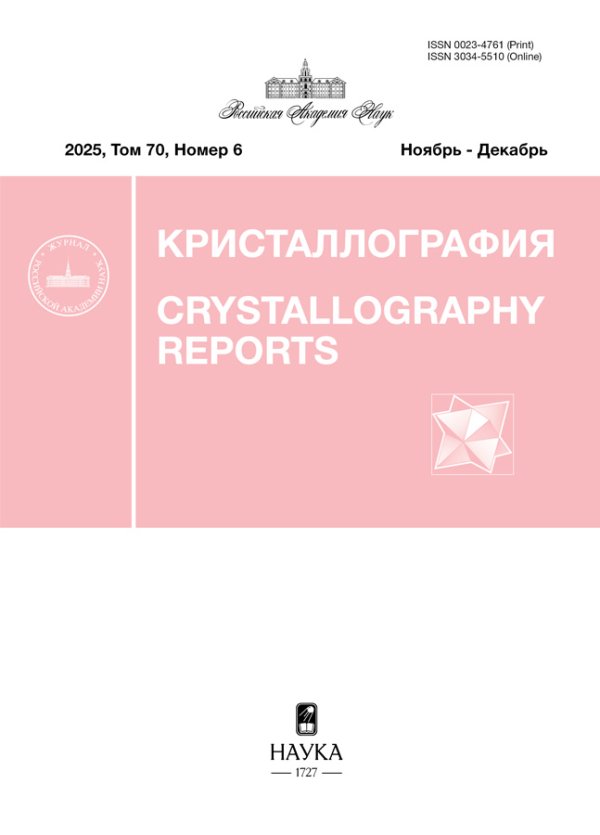Когерентная сборка в структурах с кластерами тяжелых металлов
- Авторы: Первухина Н.В.1, Борисов С.В.1, Магарилл С.А.1
-
Учреждения:
- Институт неорганической химии им. А.В. Николаева СО РАН
- Выпуск: Том 68, № 4 (2023)
- Страницы: 566-574
- Раздел: ТЕОРИЯ КРИСТАЛЛИЧЕСКИХ СТРУКТУР
- URL: https://journals.rcsi.science/0023-4761/article/view/137433
- DOI: https://doi.org/10.31857/S0023476122600525
- EDN: https://elibrary.ru/JOJBSQ
- ID: 137433
Цитировать
Полный текст
Аннотация
Проведен кристаллографический анализ структур – моноклинной Nа8[{Re4(PO)4}(CN)12]⋅18H2O⋅ ⋅CH3OH (I) и ромбической [(C6H5)4P]4 [Ta6I12(CN6)] (II), в которых кластеры тяжелых атомов значительно разрежены в пространстве так, что порядок их взаимного расположения нельзя объяснить только химическим взаимодействием. В структуре I кристаллографические плоскости с высокой атомной плотностью (“скелетные” плоскости) находятся в областях с dhkl = 10–5.5 Å и dhkl < 3 Å. В первой области фактически выделены плоскости, в которых сконцентрированы атомные группировки [Re4(PO)4], играющие роль единых массивных объектов, вторая – область, где упорядочение реализовано на уровне отдельных атомов. Кристаллографический анализ показал, что основу структуры определяют позиции тяжелых катионов Re. Поразительно, что в этой структуре в элементарной ячейке находятся 1152 подъячейки и только 32 атома Re, т.е. только 1/144 часть обеспечивает основу стабильности структуры. В структуре II также отсутствуют “скелетные” плоскости в интервале dhkl от ∼7 до ∼4 Å, и плоскости в области больших dhkl характеризуют упорядочение кластеров, а в области малых dhkl – упорядочение отдельных атомов. Геометрия и локальная симметрия кластерной группировки – Та6-октаэдра – диктуют основу трансляционной симметрии, единую подрешетку узлов, большая часть которых оказывается без этих атомов. Рассмотренные структуры демонстрируют ведущую роль тяжелых атомов в образовании трансляционной симметрии – принципиального отличия кристаллического состояния от других конденсированных состояний. Образующаяся структура сохраняет частично локальную симметрию зародышей (темплатов) атомных групп, связанных прочными химическими взаимодействиями, в том числе тяжелых атомов с легкими. Процесс образования из хаотически ориентированных и случайно расположенных темплатов кристаллической структуры – когерентная сборка – реализуется по законам динамики упругих сред, где важны не столько химические характеристики атомов, сколько их массы.
Ключевые слова
Об авторах
Н. В. Первухина
Институт неорганической химии им. А.В. Николаева СО РАН
Email: pervukh@niic.nsc.ru
Россия, Новосибирск
С. В. Борисов
Институт неорганической химии им. А.В. Николаева СО РАН
Email: pervukh@niic.nsc.ru
Россия, Новосибирск
С. А. Магарилл
Институт неорганической химии им. А.В. Николаева СО РАН
Автор, ответственный за переписку.
Email: pervukh@niic.nsc.ru
Россия, Новосибирск
Список литературы
- O'Keeffe M., Hyde B.G. // Phylosoph. Trans. Royal Soc. L., Mathemat. Phys. Sci. 1980. V. 295. P. 553.
- Delgado-Friedrichs O., O’Keeffe M. // Acta Cryst. A. 2003.V. 59. P. 351.
- Eon J.-G. // Acta Cryst. A. 2011. V. 67. P. 68.
- Yaghi O.M., O’Keeffe M., Ockwig N.W. et al. // Nature. 2003. V. 423. P. 705.
- Ockwig N.W., Delgado-Friedrichs O., O’Keeffe M. // Accts. Chem. Res. 2005. V. 38. P. 176.
- Yaghi O.M., O’Keeffe M., Kanatzidis M. // J. Solid State Chem. 2000. V. 152. P. 1.
- O'Keeffe M., Hyde B.G. // Phylosoph. Trans. Royal Soc. L. Mathemat. Phys. Sci. 1980. V. 295. P. 553.
- Delgado-Friedrichs O., Foster M.D., O’Keeffe M. et al. // Solid State Chem. 2005. V. 178. P. 2533.
- Пирсон У. Кристаллохимия и физика металлов и сплавов. М.: Мир, 1977. 472 с.
- Крипякевич П.И. Структурные типы интерметаллических соединений. М.: Наука, 1977. 288 с.
- Смирнова Н.Л. О некоторых фундаментальных элементах в частях кристаллического пространства. Кристаллохимия минералов. Л.: Наука, 1981. 109 с.
- Близнюк Н.А., Борисов С.В. // Журн. структур. xимии. 1992. Т. 33. С. 145.
- Ferraris G., Makovicky E., Merlino S. Crystallography of Modular Materials. Oxford University Press, 2004. 400 p.
- Moëlo Y., Makovicky E., Mozgova N.N. et al. // Eur. J. Mineral. 2008. V. 20. P. 7.
- Borisov S.V., Magarill S.A., Pervukhina N.V. // Russ. Chem. Rev. 2015. V. 84. № 4. P. 393.
- Борисов С.В. // Журн. структур. химии. 1992. Т. 33. № 6. С. 123.
- Борисов С.В., Магарилл С.А., Первухинa Н.В. Алгоритмы и практика кристаллографического анализа атомных структур. Новосибирск: Изд-во СО РАН, 2012. 111 с.
- Evans N.T. // Perspectives Struct. Chem. 1971. V. 4. P. 1.
- Борисов С.В., Клевцова Р.Ф., Магарилл С.А. и др. // Журн. структур. химии. 2002. Т. 43. № 4. С. 664.
- Борисов С.В., Магарилл С.А., Первухина Н.В. // Журнал структур. химии. 2014. Т. 55. № 3. С. 500.
- Nyman M. // Dalton Trans. 2011. V. 40. P. 8049.
- Борисов С.В., Магарилл С.А., Первухина Н.В. // Кристаллография. 2011. Т. 56. № 6. С. 1001.
- Пронин А.С., Брылев K.A., Штребеле M. и др. // Журн. структур. химии. 2021. Т. 62. № 7. С. 1157.
- Brandenburg K. DIAMOND. 2012. Crystal Impact GbR, Bonn, Germany.
- Борисов С.В., Магарилл С.А., Первухина Н.В. // Журн. структур. химии. 2019. Т. 60. № 8. С. 1243.
- Громилов С.А., Быкова E.A., Борисов С.В. // Кристаллография. 2011. Т. 56. № 6. С. 1013.
- Shamshurin M.V., Mikhaylov M.A., Sukhikh T. et al. // Inorg. Chem. 2019. V. 58. P. 9028.
Дополнительные файлы














